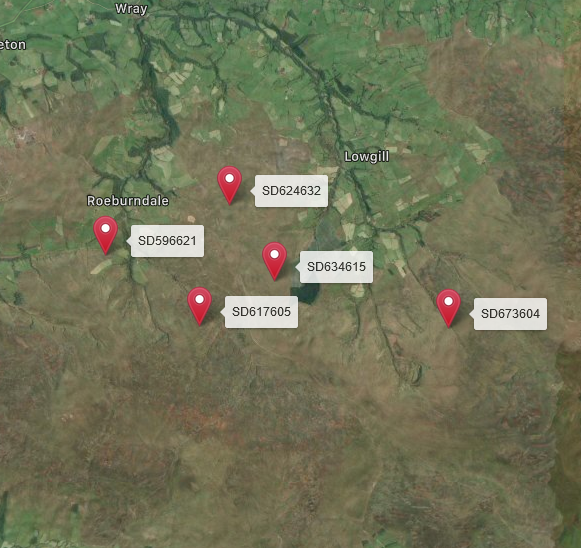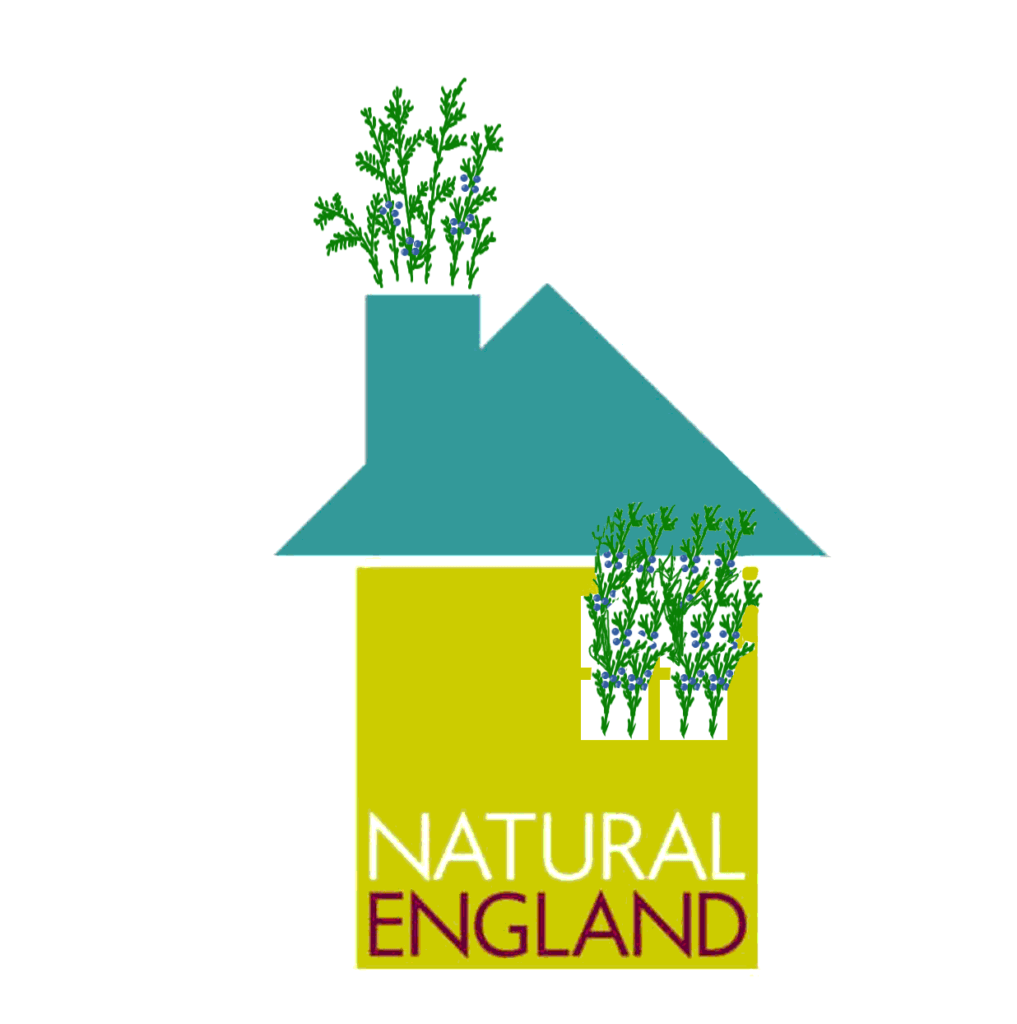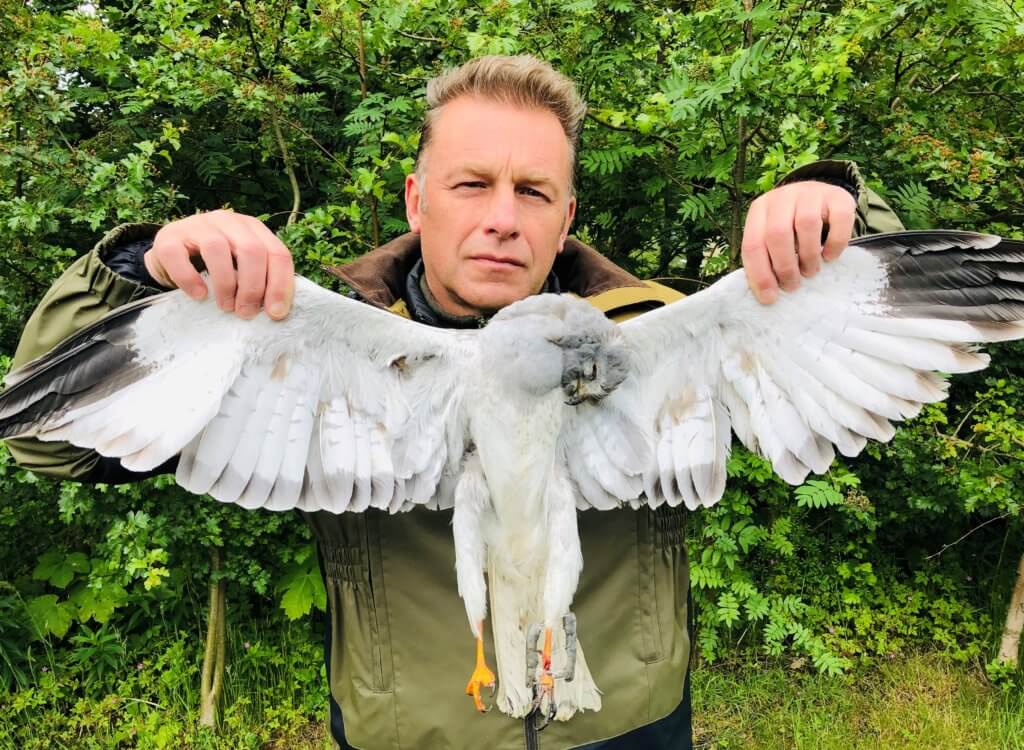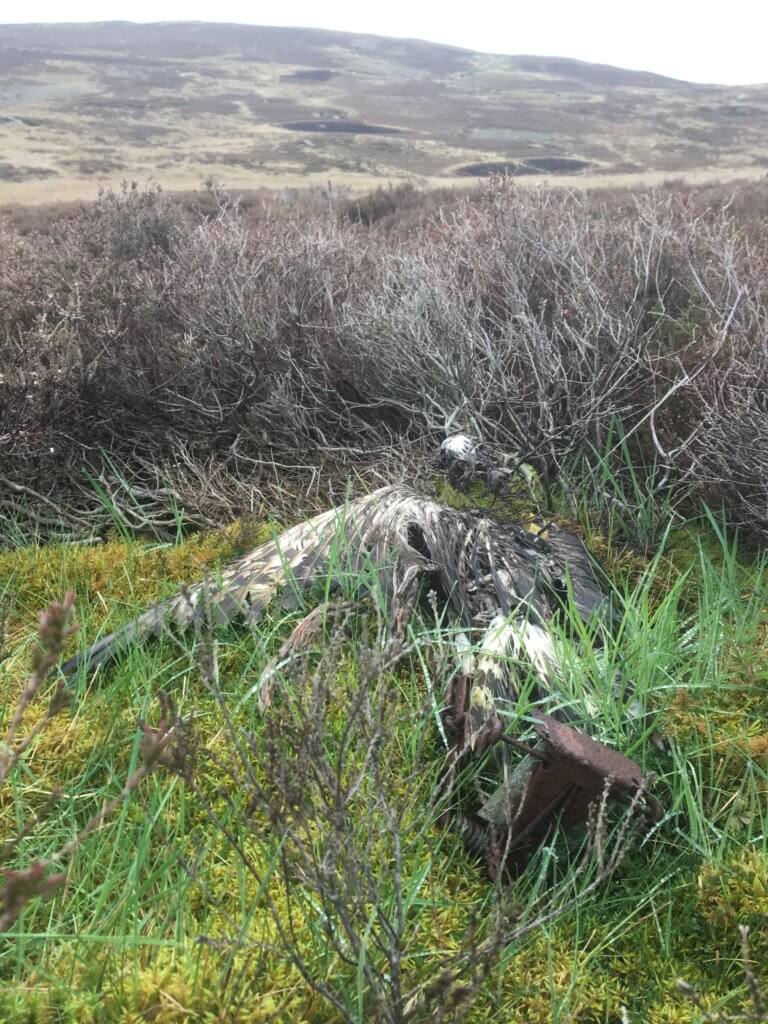
The RSPB has announced that 22 Hen Harriers have fledged from five successful nests in the Forest of Bowland – all on land owned and managed by United Utilities where they own land to protect their water catchments. This land has a few days grouse shooting on it but, despite the fact that it comprises only a third of the total area of the SPA, it seems it has all Bowland’s nesting Hen Harriers within its boundaries.

The owners of the other land (some of which is mapped by Natural England as Hen Harrier Sensitive Areas!!) within the SPA, including the Duke of Westminster (Abbeystead Estate), must feel absolutely gutted that yet again, by complete chance, all the Hen Harriers in Bowland have avoided their grouse moor landholdings and sought out the land managed for water resources instead.
Fledging is just a step on the journey of a young Hen Harrier. We know from bitter experience that some Hen Harriers fledged in Bowland don’t live very long and don’t travel very far.

This map shows another part of Bowland – not owned by United Utilities as far as I can tell – where five recently-fledged Hen Harriers have ceased tansmitting within a few weeks of fledging – none made it to Christmas let alone made it to breed themselves (most likely in their second year of life).
These are the short life statistics of those five birds:
The locations of five Hen Harriers whose satellite tags have mysteriously ceased to transmit in and adjacent to an SPA set up to protect Hen Harriers:
- SD596621 tag id 94591 tagged by NE 23 June 2010, ceased transmitting 18 Aug 2010
- SD617605 ‘Hope’ tagged by RSPB summer 2014, ceased transmitting 13 September 2014
- SD624632 Thor tagged by RSPB summer 2018, ceased transmitting 3 October 2018
- SD634615 ‘Sky’ tagged by RSPB summer 2014, ceased transmitting 10 September 2014
- SD673604 tag id 58870 tagged by NE 12 July 2010, ceased transmitting 21 August 2010
So, one smallish part of Bowland is where Hen Harriers raise their young and another smallish part of Bowland is where many of them disappear and cease sending signals via their satellite transmitters.
Some satellite-tagged Hen Harriers travel much further before they disappear mysteriously, and for some it isn’t so mysterious. Two female birds, Bowland Betty and River travelled from Lancashire to Nidderdale in Yorkshire where they both were found dead on the grouse moors of the Swinton Estate, and both had been shot (though not necessarily exactly where they were found) .
The Swinton Estate is thought to be where Natural England licensed brood meddling of Hen Harriers this year – an interesting choice considering the fact that two corpses of shot Hen Harriers have been recovered on that land.
Brood meddling, sometimes called brood management, is a controversial part of a government Hen Harrier Plan which is opposed by most raptor workers and conservation professionals (and me!).

The new Natural England Chair, my mate Tony Juniper, was interviewed by Patrick Barkham in the Guardian today. I think it’s times I unveiled my new Natural England logo, with juniper growing out of the house (drawn by @cartoonralph) to mark this day. It’s too early to say whether the juniper shoots are window dressing or real green shoots of recovery of Natural England’s moral compass.
Patrick quizzed Tony on Hen Harriers and whilst Tony was right to say ‘It’s pretty unequivocal that it [illegal killing by grouse moor interests] is still a problem‘ he then went on to sound like a fool when he was quoted as saying that the “brood management” trial ‘was vital to ensure shooting stakeholders assisted the hen harrier’s recovery‘ because that sounds like the clearest description of giving the criminals what they want that you can possibly get. And it doesn’t seem to have worked in Bowland does it? 100% of the Hen Harriers on 34% of the land – none of it owned and managed for intensive grouse shooting. The conservationists are delivering and the grouse shooting estates are not.
Natural England is on the wrong side of the argument and the wrong side of the line dividing the good guys from the bad guys. This positioning isn’t Tony’s fault, it was a side of the line chosen many years ago and dictated by Defra, but even the great communicator, my mate Tony, can’t make it sound at all sensible. A word of advice, Tony, you’ll have as much success in persuading the world that Natural England is on the right side in this debate as you do that they are the good guys in the badger cull.
Tony went on to say ‘We’ve got more chance of convincing those people to come on the journey if they can see that they’ve got part of what they think is the solution for them also on the table. My only benchmark is whether the hen harrier recovers or not. That’s all I’m concerned about.’. Well, Tony, you’ve only just arrived as a player in this issue and you aren’t making a very good job of it. Your organisation is appeasing those interests who don’t give a flying fig about Hen Harriers and whom your own data indicate as the problem. All the interest groups and individuals who really do care about the Hen Harrier are against brood meddling. You might want to refuse to answer questions on brood meddling in future on the grounds that ‘this was the last guy’s mistake, not mine’ rather than digging yourself into a self-chosen hole.
And brood meddling doesn’t stop fledged Hen Harriers being shot on grouse moors does it? Ask those five fledged Hen Harriers who lasted just a few weeks in Bowland, and then ask Bowland Betty and River – except you can’t ask any of them because they were killed in grouse shooting areas and brood meddling would have done nothing to save them. What will make a gamekeeper in Durham refrain from shooting a Hen Harrier that was brood-meddled in Yorkshire? As he lines it up in his sights he won’t even know that it was a brood-meddled bird – and honestly, do you think he’ll care?
Here are some images of dead Hen Harriers – all killed in grouse moor areas.




Mr Juniper is not easily embarrassed is he ? It takes some front to own that much craven stupidity in public, and him running a government body too. He is a careerist though.
Stevenson – careful, he’s a mate of mine. In fact according to some reports he does everything I ask him too – but that was the Daily Telegraph.
Really are you sure he’s a mate of yours? Everything you’ve thrown at Defra recently I’d be very surprised if you are still on his Christmas card list. I certainly won’t want to be your mate!!
I guess Juniper needs no enemies when he has friends like you Avery.
Mark, do you know whether these recently hatched Hen Harriers have been satellite tagged?
Chris – I don’t know, sorry.
Really good article Mark, thank you.
Tony….do a wee cost benefit analysis between brood meddling and diversionary feeding. Ask you travelling companions why the don’t try the proven technique that is cheaper by a magnitude of 100????
Tony, they don’t want a successful outcome, they just want dead hen harriers.
Some from each nest have been satellite tagged.
I really dislike brood meddling and in the long term it cannot possibly deliver what we want- harriers at a natural density. Think of the logistics if Hen Harriers increase even moderately and nest on a number of grouse moors, can you imagine the difficulty of say brood meddling just ten nests each with say 4 or 5 chicks and of course finding somebody willing to have them released on their land where release cages will be secure! No neither can I.
However I think BM may be backing the grouse shooting cabal into a corner of their own making. If any of the satellite tagged birds that were brood meddled are shot the scheme fails, if they are not shot the scheme delivers because the other harriers will probably have less chance of being shot. An increase in harriers means the scheme will fail logistically.
All I have ever wanted is for the criminals to be caught or otherwise stopped killing raptors. Although I think this can only be guaranteed by banning driven grouse shooting much has I hate BM we ( and in the long run harriers) are in a win- win with it and the DGS in a loose loose situation.
‘Think of the logistics if Hen Harriers increase even moderately and nest on a number of grouse moors’
Yes, it is based on continuing illegality. Utter madness and criminal madness at that. You have to be blind not to see that.
I truly believe that NE are playing along with the brood meddling programme because it is doomed to failure. How long has it been since Hen Harrier bred in the ‘sufficient density’ to actually allow chicks to be removed? Usually they’re blasted out of the skies before, or during, nesting. The fact that they’ve been allowed to survive by the gamekeepers for long enough to have chicks removed (Swinton?), or been permitted to breed in reasonable numbers on adjoining land (Bowland) shows what would happen if they stopped illegal killing.
The game industry may try and pat itself on the back, but really all they are doing is proving they are the limiting factor on the UK population. Now most readers of this blog are already aware, NE (and all the other SNCOs) already know this, the RSPB knows this too, but when the game industry ‘allow’ birds to survive to this stage, it proves it unequivocally. The HHAP will fail as brood meddling will not work (for all the resons outlined on RPUK and on this blog) and then we can expect Defra to tell them they’ve had their chance, and blown it.
It may be too late for this years chicks, or next years, or even the year after (although the reduction in persecution needed to justify meddling will hopefully increase numbers to a small degree over the status quo), but this will bury intensive ‘game management’ as no amount of fudge will be able to disguise it from a wider public (and political) view. Tony Juniper may not be shouting what we want him to right now, but this is a long game. He is not the enemy here.
Gosh it is hard to think how more depressing things can get, what with the shambles of Brexit and the shambles of brood melding all brought about by the current Tory Party and their failure to stop the criminality on grouse moors. I think Tony Juniper is really just a pawn in the whole horrible game of the Tories and their self interests.
However we must stick with it and not give in though, but it is really tough going just now especially as the LabourParty is an almost equal shambles in the opposite direction. I am afraid Mr Corbyn is mostly a “total waste of space” . The opposition should be ripping this Government to shreds just now on so many fronts especially grouse shooting and Brexit.
Having given careful consideration to the reasoning as to which Hen Harrier chicks are fitted with a satellite tags and those that are not, I am of the following opinion.The only people who would not welcome fitting satellite tags are shooting estates and their gamekeepers. After all when an untagged Hen Harrier is shot or trapped it becomes a missing statistic, its final resting place impossible to determine for an eternity in most cases.
Importantly we are informed tags are fitted to Hen Harrier chicks, and other targeted birds of prey, for example Golden Eagle, because they are necessary to maintain close surveillance of tagged birds after fledging. No one can argue with this important strategy because the data being collated continues to highlights the disappearance of many satellite tagged raptors found shot or trapped on or near red grouse moors. Without these tags there is no doubt these significant discoveries would not have been made.
This year many concerned people have been asking why all the Hen Harriers which fledged this season in England were not fitted with satellite tags. A very good question, especially as the majority of this years untagged fledged Harriers are likely never to be seen again. Some people would speculate that perhaps the cost of each tag would be a limiting consideration to their use. Not so according to Mr James Bray, the RSPB project officer responsible for Harrier nests in the Forest of Bowland who recently told a Bowland bird watcher the cost of these tags was not the limiting factor. Mr. Bray went on to explain, sufficient data was already being obtained from those birds which had been previously fitted with tags. This reply seems implausible, as it would be impossible to determine the fate of the un-tagged Harrier chicks post fledging, this being the reasoning behind the use of satellite tagging technology in the first place.
I think it is important to note that detecting the fate of Hen Harriers is ot the only reason they are tagged. Despite the number that are tagged each year, much useful information is still gained about the species.
I would prefer that all the young are tagged, unless the act of tagging is likely to be a problem due to bad weather or the poor health of the chick. We have not yet reached complete scientific knowledge.
Hi Terry,
it has never been the intention to satellite tag all harriers fledged in Bowland. Those tagged are essentially a representative sample of the whole population. Never mind the considerable cost over £60,000 if every bird in Bowland had been tagged this year, considering how long it takes to fit each tag it would mean a considerable time at the nest doing it, probably too long considering how touchy harriers are at the nest.
The birds tagged over the years are as I say a representative sample. If say 60% of them “disappear” on grouse moors, it is statistically valid and safe to assume that 60% of the untagged birds met the same fate. Although useful for PR it is not necessary to know where every bird died to show what is happening to the population.
For a whole host of reasons it is important that the smaller sample size of “Brood meddled” chicks are all Sat tagged and rumour has it this is not the case but we shall see. Currently the whole BM episode is extremely opaque and only long term transparency will make it scientifically valid. I would personal prefer it if the grouse moor broods in North Yorkshire and Derbyshire had some of their number tagged via RSPB rather than the data disappear into the black hole that is NE data. At least there seem to have been more widely spread nests this year and bigger broods which can only be all to the good.
Although that the Moorland Association will claim it a huge success (which it isn’t considering how many harriers there should be and we’ve had at least one nest meddled with) is sickening. A case of the criminals hailing themselves for not being quite so criminal.
Remember the Moorland Association has the ultimate power. They can take NE to court on behalf of a member and funded by that member, to be allowed to burn on blanket bog and with the case.
I attended a meeting where MA and NE put on a display of unity to debate ELMS. 10 gamekeepers outnumbered those present.
It is no accident that the moor owners have so much power, it is Defra policy.
Susan – you miustn’t give up your own power. We are much more numerous.